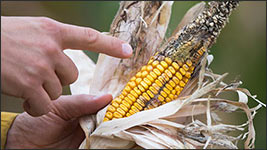HEALTH & NUTRITION...

Watch for Signs of Aflatoxin in Drought-stressed Corn
Aspergillus ear rot is being found in Kansas at the highest levels in five years.
When it comes to the weather in Kansas this year, the state is again one of the haves and the have-nots. Parts of Kansas have had more-than-normal precipitation while others, mostly in the central part of the state, are in abnormally dry to moderate drought conditions.
It is those hot, humid and drought-like conditions where aflatoxin is typically found in corn, said Doug Jardine, plant pathologist with Kansas State University (K-State) Research and Extension. He’s encouraging farmers to be on the lookout for signs that it could be present.
Aflatoxin, a poisonous carcinogen, is a naturally occurring toxin caused by the fungus Aspergillus flavus, a greenish-yellow, dime- to quarter-sized mold that grows on corn ears between the kernels. In severe cases, the mold may cover larger portions of the ear. Read more.
Dry Weather Increases Incidence of Respiratory Disease
Dry weather, smoke and dust this fall put calves at risk for respiratory disease.
Many areas of the country, including most of the western states, have seen an increase in respiratory problems in calves. Eugene Janzen, assistant dean of Clinical Practice, Veterinary Medicine at the University of Calgary, says there have been studies in western Canada in earlier years, looking at this problem in cattle on community pastures. Often they have more trouble in dry years, when conditions are dusty when gathering and working cattle. Dust can irritate the respiratory tract, making the animals more susceptible to problems.
“I used to explain to my students that when calves inhale dust, the first line of defense in the respiratory tract may be easily overwhelmed. If the inside of the nostrils and upper respiratory tract get clogged with dust, then the bacteria are not as readily exposed to the nasal secretions, which tend to kill them or help flush them out. If bacteria cling to dust particles, they can be sucked down into the lungs,” says Janzen. Read more.
Deworming Program Integral to Herd Health
Work with your veterinarian to choose the right deworming products and avoid resistance.
You’re spending hard-earned money on dewormers, but are they working hard for you? If you’re using the same product over and over, the wrong product for your operation or the right product at the wrong time, the answer may be no.
Doug Ensley, technical marketing manager with Boehringer Ingelheim Vetmedica Inc., said dewormers are the most overlooked aspect of many herd health programs, but also one of the most important.
There used to be a time when we could look at cattle and know that they most likely had parasites. Today, most of the signs of parasites in cattle are subclinical and may point to a number of other afflictions altogether. Calves aren’t growing like you think they should, weaning weights are down or the gains just aren’t what they used to be. Maybe your reproductive efficiency isn’t what you expected, and your pregnancy rates are lower than past years. Read more.
Prep for Parasites Before the Feedlot
Research shows advantage of deworming calves ahead of feedlot entrance.
Cattle on pasture pick up parasites. Worm level in any group of cattle depends on how heavily contaminated the pasture is and whether the cattle have natural resistance to nematode infections. Calves have not yet developed much resistance and tend to have heavy parasite loads if pastures are contaminated. Worm eggs passed in manure hatch into larvae that migrate onto grass.
Severe infections often result in decreased growth, rough hair coat, reduced performance, decreased appetite, and sometimes diarrhea and weight loss. Even if cattle are not showing clinical signs, strategic deworming improves performance and weight gain in beef herds. Read more.
Herd Health Affects Reproduction
Veterinarian addresses emerging disease concerns that affect reproductive efficiency.
For conscientious cow-calf producers, an important part of any herd health program is managing risk associated with reproductive diseases — those that threaten establishment and maintenance of pregnancy and may hinder fertility. In a presentation delivered during the Applied Reproductive Strategies in Beef Cattle (ARSBC) symposium Aug. 29-30 in Manhattan, Kan., Kansas State University veterinarian Gregg Hanzlicek discussed some of the more prominent diseases responsible for abortion and low fertility.
Hanzlicek said many producers are familiar with campylobacter (vibriosis) and leptospirosis, which are contagious bacterial diseases commonly known to be responsible for abortions in cattle. While they may be aware of anaplasmosis, producers may not know that this bacterial infection can affect reproduction.
Read more.
Minimize Three Main Types of Stress
Physiologic, physical and psychological stress can reduce reproductive success.
The definition of stress is the sum of reactions that influence an animal’s homeostasis, explained Reinaldo Cooke, associate professor at Oregon State University. Cooke detailed the implications stress may have on female reproductive systems on Aug. 29 at the 2017 Applied Reproductive Strategies in Beef Cattle (ARSBC) symposium in Manhattan, Kan.
Cooke began by defining homeostasis as any action that takes you outside your comfort zone. Anything that takes you away from a comfort zone is a type of stressor.
Read more.
Cattle Diseases: Common Conditions/Terms
Click here for a list of common conditions and terms related to beef cattle diseases, such as anaplasmosis, brucellosis, BVD, E. coli, IBR and others.
[Click here to go to the top of the page.]






